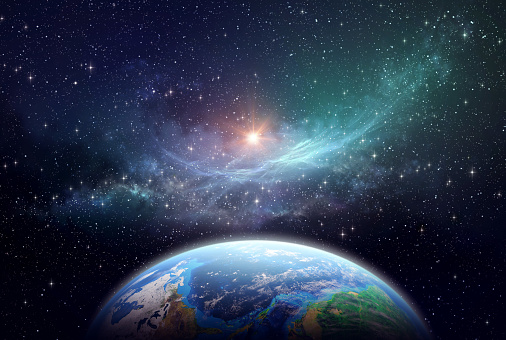What is the latest discoveries in space exploration ?
11 min readNew study puts a definitive age on Saturn’s rings — they’re really young
A new study led by physicist Sascha Kempf at the University of Colorado Boulder has delivered the strongest evidence yet that Saturn’s rings are remarkably young — potentially answering a question that has boggled scientists for well over a century.
The research, to be published May 12 in the journal Science Advances, pegs the age of Saturn’s rings at no more than 400 million years old. That makes the rings much younger than Saturn itself, which is about 4.5 billion years old.
“In a way, we’ve gotten closure on a question that started with James Clerk Maxwell,” said Kempf, associate professor in the Laboratory for Atmospheric and Space Physics (LASP) at CU Boulder.
The researchers arrived at that closure by studying what might seem like an unusual subject: dust.
Kempf explained that tiny grains of rocky material wash through Earth’s solar system on an almost constant basis. In some cases, this flux can leave behind a thin layer of dust on planetary bodies, including on the ice that makes up Saturn’s rings.
In the new study, he and his colleagues set out to put a date on Saturn’s rings by studying how rapidly this layer of dust builds up — a bit like telling how old a house is by running your finger along its surfaces.
“Think about the rings like the carpet in your house,” Kempf said. “If you have a clean carpet laid out, you just have to wait. Dust will settle on your carpet. The same is true for the rings.”
It was an arduous process: From 2004 to 2017, the team used an instrument called the Cosmic Dust Analyzer aboard NASA’s late Cassini spacecraft to analyze specks of dust flying around Saturn. Over those 13 years, the researchers collected just 163 grains that had originated from beyond the planet’s close neighborhood. But it was enough. Based on their calculations, Saturn’s rings have likely been gathering dust for only a few hundred million years.
The planet’s rings, in other words, are new phenomena, arising (and potentially even disappearing) in what amounts to a blink of an eye in cosmic terms.
“We know approximately how old the rings are, but it doesn’t solve any of our other problems,” Kempf said. “We still don’t know how these rings formed in the first place.”
From Galileo to Cassini
Researchers have been captivated by these seemingly-translucent rings for more than 400 years. In 1610, Italian astronomer Galileo Galilei first observed the features through a telescope, although he didn’t know what they were. (Galileo’s original drawings make the rings look a bit like the handles on a water jug). In the 1800s, Maxwell, a scientist from Scotland, concluded that Saturn’s rings couldn’t be solid but were, instead, made up of many individual pieces.
Today, scientists know that Saturn hosts seven rings comprised of countless chunks of ice, most no bigger than a boulder on Earth. Altogether, this ice weighs about half as much as Saturn’s moon Mimas and stretches nearly 175,000 miles from the planet’s surface.
Kempf added that for most of the 20th Century, scientists assumed that the rings likely formed at the same time as Saturn.
But that idea raised a few issues — namely, Saturn’s rings are sparkling clean. Observations suggest that these features are made up of roughly 98% pure water ice by volume, with only a tiny amount of rocky matter.
“It’s almost impossible to end up with something so clean,” Kempf said.
Cassini offered an opportunity to put a definitive age on Saturn’s rings. The spacecraft first arrived at Saturn in 2004 and collected data until it purposefully crashed into the planet’s atmosphere in 2017. The Cosmic Dust Analyzer, which was shaped a bit like a bucket, scooped up small particles as they whizzed by.
Engineers and scientists at LASP designed and built a much more sophisticated dust analyzer for NASA’s upcoming Europa Clipper mission, which is scheduled to launch in 2024.
The team estimated that this interplanetary grime would contribute far less than a gram of dust to each square foot of Saturn’s rings every year — a light sprinkle, but enough to add up over time. Previous studies had also suggested that the rings could be young but didn’t include definitive measures of dust accumulation.
Stroke of luck
The rings might already be vanishing. In a previous study, NASA scientists reported that the ice is slowly raining down onto the planet and could disappear entirely in another 100 million years.
That these ephemeral features existed at a time when Galileo and the Cassini spacecraft could observe them seems almost too good to be true, Kempf said — and it begs an explanation for how the rings formed in the first place. Some scientists, for example, have posited that Saturn’s rings may have formed when the planet’s gravity tore apart one of its moons.
“If the rings are short lived and dynamical, why are we seeing them now?” he said. “It’s too much luck.”
Co-authors on the new study include Nicolas Altobelli of the European Space Agency; Jürgen Schmidt of the Freie Universität Berlin; Jeffrey Cuzzi and Paul Estrada of the NASA Ames Research Center; and Ralf Srama of the Universität Stuttgart.
Space scientists have discovered just how much they can accomplish when they work together, with incredible feats achieved this year through collaborations with commercial industry and foreign nations.
Successful partnerships in 2022 have included the launch and calibration of the most powerful space telescope in the world and photographing the never-before-seen supermassive black hole at the center of the Milky Way galaxy.
The year also has shown what can go wrong.
Stray rocket junk in an unpredictable orbit smashed into the moon, for example, creating a new crater. And NASA’s mega moon rocket, the Space Launch System, has stumbled on its way to its first lunar mission, with the agency encountering several problems with contractors’ work during a critical test this spring.
Whether the rest of the year will include the inaugural moon-bound Artemis mission, the United States’ return to human deep space exploration, remains to be seen. Read more about the year’s biggest moments in space, so far.
James Webb Space Telescope opens for business

The James Webb Space Telescope will deliver its first full-color images on July 12.
The most powerful observatory in space hit its mark at a destination 1 million miles from Earth in late January and unfurled its complicated, tennis court-size sun shield. Engineers have since calibrated the Webb telescope’s scientific instruments, exceeding expectations for its level of precision.
Astronomers anticipate the telescope will stoke a golden age in our understanding of the cosmos, providing snapshots of space billions of light-years away.
On July 12, the James Webb Space Telescope, a partnership between NASA, the European Space Agency, and the Canadian Space Agency, will deliver its first full-color images. What those first cosmic targets will be is a closely guarded secret.
Webb is expected to observe some of the oldest, faintest light in the universe. The telescope will focus on a period less than 300 million years after the Big Bang, when many of the first stars and galaxies were born.
Scientists will also use the telescope to peer into the atmospheres of planets outside our solar system, called exoplanets. Discoveries out there of water and methane, for example, could be signs of potential habitability or biological activity.
NASA’s mega moon rocket crawls out of storage

NASA took the Space Launch System, or SLS, which will send a spacecraft to the moon, out of storage for a critical fueling and countdown test.
A rocket as tall as the Statue of Liberty came out of hiding in March as the U.S. space agency rolled it to a Florida launchpad for a crucial test.
The Space Launch System, or SLS, is an imposing 5.75 million-pound behemoth built to blast a spacecraft to the moon for the Artemis missions, a NASA human space exploration campaign. The program will eventually send people to the moon and Mars.
Originally, NASA believed the first uncrewed flight could happen as early as May. But several problems arose during the test, creating more delays. It’s unclear when the rocket will be ready for takeoff.
The rocket is thought to be the most expensive ever built, with each launch estimated to cost over $4 billion. For perspective, that’s about one-fifth of the entire NASA budget.
NASA inspector general Paul Martin, an agency watchdog, warned a U.S. House committee in March that the rocket, a government-mandated project with a bloated budget, will “inhibit, if not derail, NASA’s ability to sustain its long-term human exploration goals.”
Saturn’s moon could be an ocean world

Saturn’s moon Mimas has been known for its striking resemblance to Star Wars’ Death Star, a killing machine that looks like a planet.
It has not been known for its resemblance to a place that could potentially support life — until now.
New research published in the planetary science journal Icarus described how scientists unexpectedly found signs of an ocean beneath the moon’s icy shell. Though the study didn’t find definitive proof, there’s now compelling evidence. Water is an important ingredient for habitability, creating environments where life can potentially thrive.
Mimas may not be a frozen chunk of ice, after all.
Peculiar widespread Martian aurora discovered

New overview images of Mars have revealed a stunning green light show in the planet’s sky.
Much of Mars’ atmosphere apparently has a wormlike streak, an aurora similar to the Northern Lights sometimes visible on Earth. The Martian aurora is a glowing, twisted band of ultraviolet light, stretching thousands of miles from the dayside, which faces the sun, to the back of the planet.
A United Arab Emirates Space Agency probe orbiting Mars, known as Hope, took the snapshots.
No one knows how it’s happening, given that scientists believe Mars’ magnetic field largely deteriorated billions of years ago. Magnetic fields guide high-energy streams of electrons from the sun into a planet’s atmosphere.
Oops! Rocket junk slams into the moon

A rocket booster thought to be left over from a Chinese lunar mission smashed into the moon in March, making the hunk of metal the first-known space junk to unintentionally crash into our natural satellite.
Scientists expected the booster would leave a crater about 65 feet long. China has denied the debris is from its space program.
The rocket was one of many left in a “chaotic” orbit, meaning its cosmic track could change in a mathematically unpredictable way. When rockets are in low-Earth orbit, not far above many satellites, they’ll stay there with a possibility to re-enter Earth’s atmosphere. If a rocket is sent farther out to a roomy orbit around the sun, on the other hand, it’ll essentially be lost forever.
But if it’s dropped off in that intermediate zone between the two, still orbiting Earth but far enough to get an occasional tug from the moon’s gravity, that could lead to several possible outcomes: The debris could fall back to Earth, get spit out into an orbit around the sun, or hit the moon.
Based on outer space policies and agreements, leaving a rocket in this chaotic state — and not keeping tabs on its whereabouts — isn’t a crime.
Astronomers take the first photo of massive Milky Way black hole

At the center of the Milky Way is a giant black hole, and for the first time ever, astronomers were able to see it.
Black holes don’t have surfaces, like planets or stars. Instead, these mysterious cosmic objects have a boundary called an “event horizon,” a point of no return. If anything swoops too close to that point, it will fall inward, never to escape the hole’s gravity.
With the power of eight linked radio dishes from around the world, the Event Horizon Telescope took a picture of the shadow of the supermassive black hole known as Sagittarius A*. Hundreds of scientists from 80 institutions around the globe worked together to collect, process, and piece together fragments of data to make the picture.
Up until three years ago, any depiction of a black hole was merely an artist’s interpretation or a computer model. Now scientists have a snapshot of the real deal, which spans 27 million miles.
With financial support from the National Science Foundation and other groups, scientists plan to enhance their technology to make the image drastically sharper.
Hubble confirms comet as the biggest on record

The Hubble Space Telescope determined a recently discovered comet has a nucleus spanning 85 miles, making it the largest space snowball ever observed.
This bright ball of ice, dust, and rock, Comet Bernardinelli-Bernstein, is twice the width of Rhode Island and probably weighs 500 trillion tons. Researchers say the scale of this comet is significant because it provides a clue about the size range of comets orbiting in the distant outskirts of our solar system.
Comets, known for their millions-of-miles-long tails, are among the oldest objects in the solar system. These icy bodies are leftover from the early days of the planets’ formation.
Bernardinelli-Bernstein is approaching the sun from the edge of the solar system at 22,000 mph. Though the imposing boulder has often been described as “headed this way,” space is a big place. Saturn is closer to Earth than the comet will ever come.
Hubble has transformed our understanding of the universe, its view from orbit unleashing a flood of cosmic discoveries that have changed astronomy forever. From its explorations of dark matter to its quest to determine the age of the universe, Hubble has helped answer some of the most compelling astronomical questions of our time, and revealed enigmas that we never knew existed. Throughout history, humanity’s eyes on the universe have never seen with more clarity or focus; find out how Hubble has opened the window to the grandeur and mystery of space.
——————————————–FAQs———————————–











